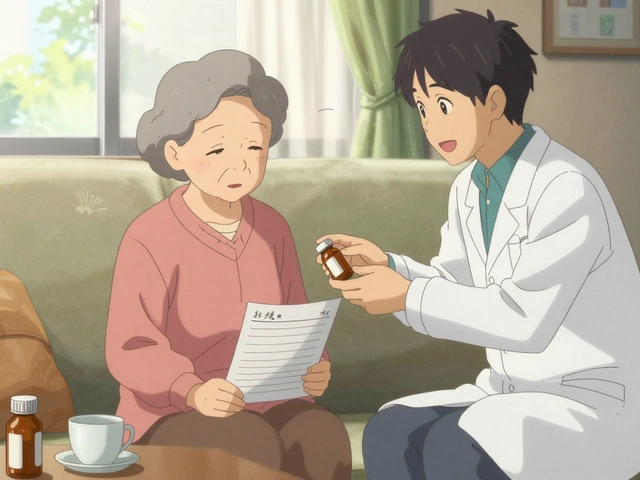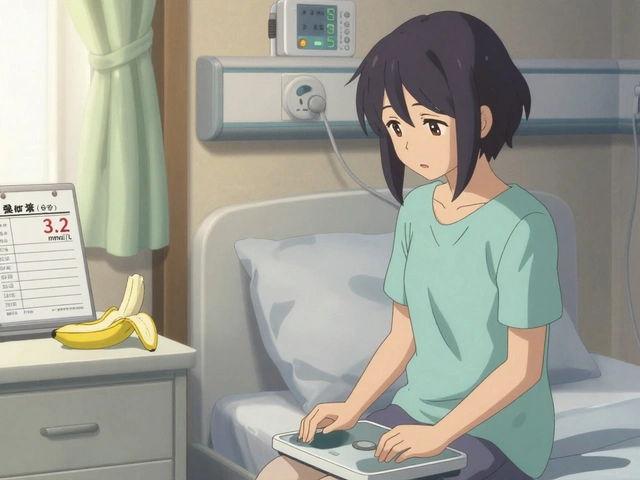Polypharmacy Risk Calculator
Assess Your Medication Risk
This tool helps you understand how your current medications might affect your risk of frailty. Based on medical research, each additional medication increases frailty risk by 12%.
When an older adult takes five or more medications daily, they’re not just managing health conditions-they’re walking a tightrope. Each pill adds risk. For someone who’s already frail-losing strength, moving slowly, feeling constantly tired-those risks multiply. Frailty and polypharmacy don’t just coexist; they feed each other. And the result? More falls, more hospital stays, more confusion, and a life that shrinks instead of grows.
What Frailty Really Means in Older Adults
Frailty isn’t just being old. It’s a measurable state of decline. The medical definition, called the Fried frailty phenotype, looks at five things: unintentional weight loss, feeling exhausted most days, weak grip strength, slow walking pace, and low physical activity. If someone has three or more of these, they’re frail. One or two? They’re prefrail-and at high risk of slipping into full frailty if nothing changes.It’s not about age. It’s about function. A 70-year-old who walks briskly, eats well, and can lift groceries isn’t frail. A 78-year-old who needs help getting out of a chair, hasn’t gained weight in months, and skips walks because they’re too tired? That’s frailty. And it’s invisible until it’s too late.
Polypharmacy: When More Medicines Mean Less Health
Polypharmacy means taking five or more medications a day. Hyper-polypharmacy? Ten or more. In the U.S., nearly half of older adults now fall into that category. That number jumped from 23.5% in 1999 to 44.1% in 2018. For people with heart disease or diabetes, it’s even worse-over 60% are on five or more drugs.But here’s the problem: most of these meds weren’t prescribed together. One doctor handles blood pressure. Another handles arthritis. A third handles sleep. No one looks at the whole picture. The result? Overlapping side effects. Dizziness from a blood pressure pill. Constipation from an opioid. Confusion from an anticholinergic. These don’t just add up-they collide.
Studies show each extra medication increases the chance of frailty by 12%. That means someone on seven drugs has a 2.5 times higher risk of becoming frail over eight years than someone on two. And once frail, the body becomes more sensitive to drugs. A dose that was fine last year now causes dizziness. A drug that helped before now triggers falls. It’s a spiral.
The Vicious Cycle: How Frailty and Polypharmacy Feed Each Other
It’s not just that polypharmacy causes frailty. Frailty causes polypharmacy too.Frail older adults develop more conditions-falls lead to fractures, which lead to pain meds. Loss of appetite leads to nutritional supplements. Sleep problems lead to sedatives. Mobility loss leads to muscle relaxants. Each new diagnosis brings a new prescription. And because frail people often see multiple specialists, no one steps back to ask: Do we still need all of these?
Research from the MIDUS study found that even after adjusting for age, chronic illnesses, and BMI, people on five or more medications were nearly three times more likely to be frail. The cutoff? Just 4.5 medications. That’s not a lot. It’s less than a typical daily routine.
And the impact isn’t just physical. People on many drugs report worse quality of life-not because their diseases are worse, but because managing pills eats up their energy. They spend hours sorting pillboxes, remembering schedules, dealing with side effects. They stop going out. Stop cooking. Stop seeing friends. The meds meant to help them live longer end up making life smaller.
Who’s Most at Risk?
Not everyone faces the same level of risk. Women are more likely to be on multiple medications than men-48.5% vs. 39.1%. Non-Hispanic White older adults have higher rates than Black or Hispanic peers. Those with less education are more likely to be on five or more drugs. And the highest rates? In nursing homes-over 96% of residents take ten or more medications daily.But the biggest red flag? Hospitalization. Nearly all hospitalized older adults are on polypharmacy. That’s not because they’re sicker-it’s because hospitals add meds without removing any. A patient comes in for pneumonia, gets antibiotics, then a laxative for constipation, then a sleep aid, then a stomach protector for the antibiotic. By discharge, they’re on ten drugs. And they go home with all of them.

What’s Being Done? Tools to Cut the Pill Burden
There are proven ways to reduce this burden. Two of the most trusted are the Beers Criteria and the START/STOPP guidelines.The Beers Criteria, updated in 2019 by the American Geriatrics Society, lists drugs that are risky for older adults-like benzodiazepines for sleep, anticholinergics for overactive bladder, and certain NSAIDs. These drugs are often unnecessary and dangerous for frail people.
START/STOPP does the opposite. It asks: Are we missing something? Are we giving too much? START tells doctors which medications should be added-like a flu shot or a vitamin D supplement. STOPP tells them which to stop-like long-term proton pump inhibitors or inappropriate antipsychotics.
When clinics use these tools, inappropriate prescribing drops by 30-50%. But here’s the catch: most doctors don’t use them. A 2023 survey found that 61% of primary care physicians rarely review medication lists for deprescribing. Why? Time. Appointments are 15 minutes. Reviewing 12 pills takes longer than that.
How to Start Deprescribing: A Realistic 3-Step Method
You don’t need a specialist to begin. You can start today.- Review the list - Get every medication, supplement, and OTC drug written down. Include creams, patches, inhalers. Ask your pharmacist for a complete list. Many pharmacies offer free medication reviews.
- Ask the right questions - For each drug, ask: Why am I taking this? What problem is it solving? What happens if I stop? Is there a safer alternative? Is it still needed?
- Test one at a time - Don’t stop everything at once. Pick one that’s least essential or most likely to cause harm. For example, a sleeping pill that causes dizziness. Reduce the dose slowly over weeks. Monitor for changes: Are you sleeping worse? Or are you less dizzy? Are you falling less?
A protocol developed by Dr. Cynthia Boyd at Johns Hopkins shows this works. In 6 months, patients using this method reduced inappropriate meds by 28%. And 92% stuck with it because they felt better-not worse.
Real Stories: What Happens When People Stop Unnecessary Meds
In the EMPOWER trial, 76% of older adults successfully stopped at least one medication-often a sleeping pill or an acid reflux drug. After three months, they reported a 32% improvement in quality of life. One woman, 82, stopped her nighttime antihistamine for allergies. She’d been taking it for 15 years. She thought it helped her sleep. But it was making her dizzy. After stopping, her falls dropped from three a month to zero. She started walking again.On the flip side, a man in his 70s was on eight drugs for hypertension, arthritis, insomnia, and acid reflux. He was constantly tired and confused. His doctor cut four-two sleep aids, a muscle relaxant, and a proton pump inhibitor. Within six weeks, his energy returned. His memory cleared. He started gardening again.
But not everyone succeeds. Many patients are scared. One survey found 54% of older adults fear stopping a drug will make them sicker. Others don’t know how to ask. And some doctors resist-because they’re not trained, or they’re worried about liability.

Who Can Help? Pharmacist-Led Care Is the Game Changer
The most effective way to reduce polypharmacy isn’t a new drug. It’s a pharmacist.Pharmacist-led medication therapy management reduces adverse events by 34%. These pharmacists don’t just fill prescriptions-they review them. They spot interactions. They question duplicates. They talk to patients in plain language. They coordinate with doctors.
Academic medical centers are ahead: 72% have geriatric pharmacists on staff. Community hospitals? Only 28%. That’s a gap. If you’re managing care for an older adult, ask: Can we get a pharmacist involved? Many insurance plans now cover this service.
Tools like Medisafe and Round Health help patients track pills and get reminders. But they don’t solve the root problem. Only a trained professional can decide what to stop.
What’s Changing in 2025?
The landscape is shifting. In January 2024, the FDA approved the first AI-powered deprescribing tool: MedWise Risk Score. It analyzes a patient’s full drug list and predicts the risk of side effects with 37% greater accuracy than human judgment alone.The American Geriatrics Society’s Age-Friendly Health Systems initiative now includes 2,850 hospitals and clinics. They follow the 4Ms: What Matters to the patient, Medication review, Mentation (cognition), and Mobility. Where it’s used, inappropriate polypharmacy dropped 24% in just one year.
And the NIH is funding a $15 million trial called FRAIL-PHARM, testing a pharmacist-led program specifically for frail older adults. Results are due in 2027. Meanwhile, the WHO is pushing for a 50% reduction in severe medication harm by 2030.
What You Can Do Right Now
If you care for an older adult-or are one-here’s your action list:- Get a full medication list from your pharmacist. Include vitamins and OTC drugs.
- Ask: Which of these are truly necessary? Which might be causing side effects?
- Start with one drug that’s linked to dizziness, confusion, or constipation.
- Don’t stop cold turkey. Work with your doctor to taper safely.
- Track changes: energy levels, balance, appetite, sleep, bowel movements.
- Request a pharmacist consult if your clinic offers one.
Frailty isn’t inevitable. Polypharmacy isn’t unavoidable. The goal isn’t to take fewer pills-it’s to take the right ones. To live longer isn’t the point. To live better is.
What is the difference between polypharmacy and appropriate prescribing?
Polypharmacy simply means taking five or more medications. Appropriate prescribing means every drug is necessary, effective, and safe for that person’s age, health, and goals. Someone can be on three meds and still be overmedicated if one is unnecessary. Someone on eight meds might be appropriately treated if each one is critical and monitored. It’s not about the number-it’s about the reason.
Can stopping medications make someone sicker?
Sometimes, yes-but usually not. Most drugs stopped in deprescribing are no longer needed, ineffective, or causing harm. For example, a 90-year-old on a statin for cholesterol with no heart disease may not benefit, but could have muscle pain. Stopping it often improves quality of life. Serious risks come from stopping essential drugs like blood pressure meds too quickly. That’s why tapering and medical supervision matter.
Are over-the-counter drugs part of the problem?
Absolutely. Many older adults take OTC meds daily-antacids, sleep aids, pain relievers, laxatives-without telling their doctor. A common sleep aid like diphenhydramine is an anticholinergic, which increases dementia and fall risk in seniors. A daily laxative might mask a bigger issue like dehydration or thyroid problems. Always include OTCs in your medication review.
How long does it take to see improvements after deprescribing?
It varies. For drugs that cause dizziness or confusion, improvements can happen in days to weeks. For muscle weakness from long-term steroid use, it may take months. Most people notice better sleep, more energy, or fewer falls within 4-8 weeks. The key is tracking changes-not assuming it’s too late to feel better.
Why don’t doctors talk about deprescribing more often?
Many doctors weren’t trained in it. Time is limited. They’re paid to add treatments, not remove them. Some fear legal risk if a patient gets worse. Others assume the patient wants every possible drug. But awareness is growing. With new guidelines and pharmacist support, more practices are starting to prioritize deprescribing as part of standard care.







Comments
Ginger Henderson
Ugh, another article telling us to stop meds like they’re candy. My grandma’s on 12 pills and she’s fine. If it ain’t broke, don’t fix it.
Stephanie Deschenes
Actually, this is one of the clearest summaries I’ve read on polypharmacy. The Fried phenotype breakdown alone is worth the read. Pharmacist-led reviews are underutilized - if your clinic doesn’t offer one, ask for a referral. It’s covered by Medicare Part B now.
Amanda Meyer
There’s a dangerous myth here that ‘more pills = better care.’ But the data doesn’t lie - each additional medication increases frailty risk by 12%. And yet, we still treat geriatrics like a checklist of diseases instead of a whole person. The 4Ms framework is the bare minimum. We need systemic change, not just individual tweaks.
Jesús Vásquez pino
Wait, so you’re saying I should stop my dad’s statin because he’s 90 and never had a heart attack? That’s terrifying. What if he drops dead tomorrow? I’m not playing Russian roulette with my dad’s life.
Wendy Edwards
i read this and cried. my mom took 8 pills a day and was so tired she stopped baking. we stopped the sleep aid and the antacid - she’s been sleeping better, laughing more, and even started walking to the mailbox again. no one told us to ask. just saying… you can feel better.
stephen riyo
...but...what if...I mean...I just...I don't know...I'm scared? 😅
Albert Guasch
While the empirical evidence supporting deprescribing is robust - particularly in light of the Beers Criteria and START/STOPP guidelines - the clinical implementation remains fraught with systemic inertia. The physician’s cognitive load, compounded by fragmented electronic health records and fee-for-service incentives, disincentivizes comprehensive medication reconciliation. A paradigm shift toward value-based geriatric care, anchored in interdisciplinary teams, is not merely beneficial - it is imperative.
Bethany Buckley
Oh, so now we’re supposed to trust pharmacists with our lives? 🤔 How quaint. I mean, if we’re going to outsource medical judgment to someone who just… counts pills… then why not just let the AI do it? MedWise Risk Score already outperforms humans by 37%. The real tragedy isn’t polypharmacy - it’s our collective surrender to mechanistic, soulless healthcare. 🌿✨
Cynthia Boen
This is why we can’t have nice things. Every time someone says ‘just stop one pill,’ a geriatrician dies. You think your grandma’s dizziness is from a sleeping pill? Nah. It’s from the fact that you didn’t take her to the doctor for 18 months. Stop blaming the meds and start blaming the family who ignored the signs.
hannah mitchell
My aunt cut her anticholinergic last year. No falls since. She says she feels like herself again. I wish someone had told us sooner.